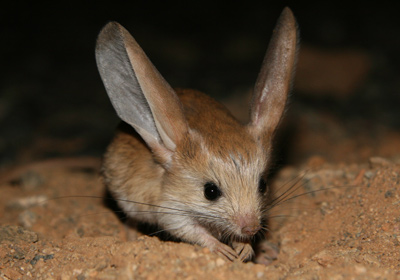Photos: First ever footage of the elusive long-eared jerboa
Photos: Elusive long-eared jerboa caught on video for the first time
Jeremy Hance, mongabay.com
December 10, 2007
Extraordinary footage of the endangered long-eared jerboa was taken by scientists from the EDGE; this is the first time the jerboa, a hopping rodent that sports massive ears, has ever been caught on film. The nocturnal animal was captured springing across the desert sands, digging a burrow, and, oddly enough, persistently seeking the comfort of a scientist’s sandals.
 Courtesy of ZSL |
The long-eared jerboa lives in the desert of northwestern China and southern Mongolia. Little is known about its behavior, but it is believed that its movement by quick jumps aids it in evading predators. Currently the long-eared jerboa is believed to be threatened by human disturbance of its deserts, livestock intrusion, and droughts. Dr. Jonathan Baillie, the lead scientists on the expedition which took the footage, described his first encounter with the small mammal on the EDGE blog: “As I peered in the trap my eyes were met with one of the most unusual creatures I had ever seen. I could not believe that such a strange and delicate looking animal could be at home in such a harsh environment.”
The long-eared jerboa is the only species in its genus, and it is this particular uniqueness that led EDGE scientists to focus on its conservation. Until now, it had garnered no conservation attention. EDGE has hired a local Mongolian naturalist, Uuganbadrakh, as an EDGE fellow to conduct research of this little-known animal. With this research they hope to produce a management plan for the long-eared jerboa’s continued survival.
 Courtesy of ZSL |
The expedition to find the long-eared jerboa also ran into other strange desert animals, such as the thick-tailed pygmy jerboa, the Siberian shrew, and the long-eared hedgehog.
Only a year old, the EDGE conservation organization works to save animals that are both endangered and evolutionary distinct, in this way they work with many animals that have received almost no attention from the conservation community and are mostly unknown by the public. Earlier in the year, EDGE scientists discovered proof that the long-beaked echidna still exists in Papua New Guinea.
To see the footage and photos: http://www.edgeofexistence.org/edgeblog/?p=213